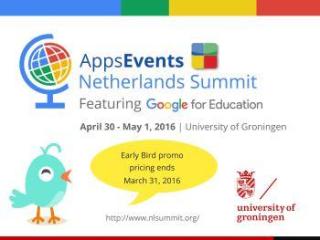Notes from the Google For Education 2016 Netherlands Summit
| Date: | 02 May 2016 |
| Author: | André Rosendaal |

On April 30 and May 1st, the complete ICTOL team (Sake, Peter, André) participated in the Google For Education 2016 Netherlands Summit, organized by the RUG in co-operation with several Google Apps community members. During these two days, we attended several sessions led by Google Apps EDU Certified Trainers and/or Google Certified Teachers. The sessions focused on Google Apps for Education and covered apps like Classroom, Docs, Sheets and Slides, and of course the use of Google Drive as the place where to store and share your files.
One of the tools that impressed us was Google Classroom. In itself, it offers basic functionality such as uploading files, adding announcements and creating assignments. However, it immediately becomes clear that the integration with Google Drive makes it easy to send and collect files for assignments. Assignments can e.g. be sent as a Google document, whereby each student receives a copy - they then work individually or with other students on their assignment. This assignment is a file on Google Drive that the teacher can access, view and comment on. The strength of Classroom is that there are many add-ons that offer extra functionality. I was especially attracted by the combination Doctopus and Goobric, two of the available add-ons. These enable teachers to assess student work by using a rubric (created as spreadsheet in Sheets) in combination with an assignment via Classroom. By simple reading the sent in work and clicking on the appropriate cells in the rubric (optionally adding comments), the teacher assesses the work on the basis of the rubric and sends the review to the students.
Many other tips and tricks for both the Chrome browser and the different Google apps were presented. One of the things that stunned me was the Motion Chart: based on data in a spreadsheet, you can create a graph that visualizes how a certain value changes over time (e.g. growth). An example showing the results of an experiment with beans growing under different light circumstances
Using a column with locations in a spreadsheet, it is a piece of cake to create maps with data connected to these locations. The add-on for this is called 'Mapping Sheets'.
Many of these samples were shown during the Summit. We concluded that it would be worthwhile to try and increase the knowledge of the Google Apps for Education amongst staff and students.

